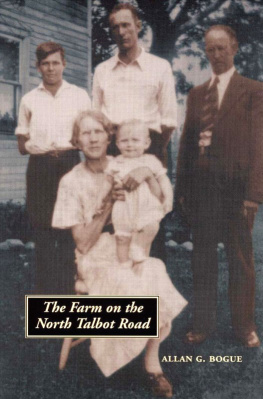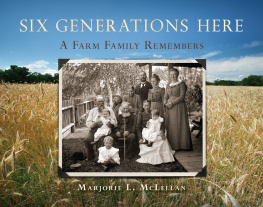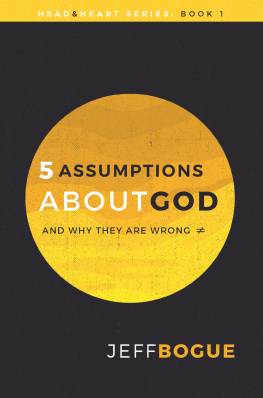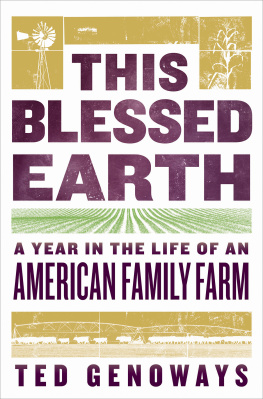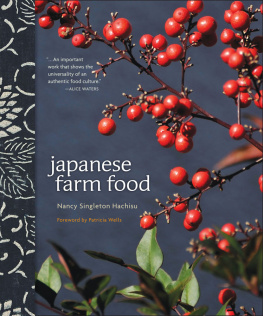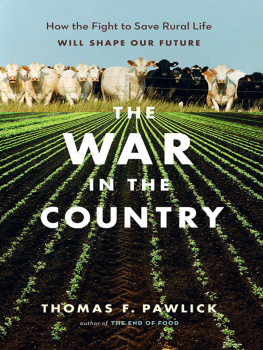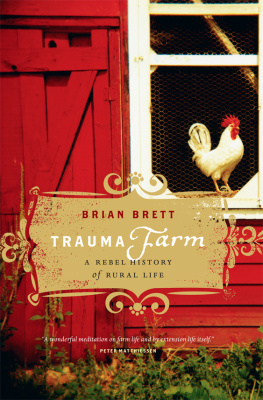The Farm on the North Talbot Road
by
Allan G. Bogue
University of Nebraska Press
Lincoln and London
2001 by the University of Nebraska Press
All rights reserved.
Library of Congress Cataloging-in-Publication Data
Bogue, Allan G.
The farm on the North Talbot Road / Allan G. Bogue.
ISBN 0-8032-6189-6 (pbk. : alk. paper)
1. Dairy farmingOntario. 2. Dairy farmsOntario. 3. Farm lifeOntario. 4. Bogue, Allan G. I. Title sf227.c2 b64 2001
636.2'142'0971325dc21
2001017488
Illustrations are courtesy of the author unless otherwise credited.
Dedicated to my family and to all the others who helpedgive special meaning in my mind to the North Talbot Road
Illustrations
Frontispiece
The farmstead
Following page 98
The gravestones of John and Elizabeth Bogue George and Eleta Britton Bogue on their wedding day George and Eleta and family, 1915
Covent Garden Market Square, 1909
Covent Garden Market Square, 1936
Leonard and Irene Barney Bogue, 1935
Eleta, George, grandson Arthur, and sons Allan and Leonard, 1937
Eleta and the young farm Collie, Bingo, 1938
The milking herd on Arthur and Irenes farm, 1980
The author in front of a Bren gun carrier, 1944
Maps
1. North Talbot Road neighborhood lot and property lines, 1878
2. The home place, 34
3. The back fifty, 35
Tables
1. Reproduction in the dairy herd (official registrations)
2. Records of performance qualifiers
3. Farm means in the Oxford area (1931) and condensery area (193738)
4. Ontario farm product prices and livestock values
Preface
In this book I have tried to describe how we did things on an Ontario farm during the 1930s. I have not tried to write an autobiography or detail the growing pains that I experienced while I moved through my early and middle teens. Nor did I wish to write a family history. When completed, my account contained elements of all of these things. But livestock husbandry and market gardening and the impact of the depression of the 1930s upon our farm life provide the books central focus. Some readers may wish to know our family and our neighbors somewhat better than the first two chapters allow by reading chapter 9, Neighborhood and Family, before meeting the Holsteins, experiencing the joys of picking tomatoes, and rattling off to market as described in chapters 38. Others may be more interested in the story line than in the specifics of herd management and agricultural prices detailed in the two appendixes.
But why devote a book to so ordinary a thing as a family farm? As a history teacher at the University of Iowa and the University of Wisconsin, Madison, I was lucky enough to become acquainted with a number of the young economic historians who were creating a new economic history between the mid-1950s and the late 1970s. During those years I attended symposia and professional meeting panels in which these scholars discussed their work and responded to the questions and criticisms of members of the audience. They were particularly intrigued by the institution of slavery in the American South, and argument often centered upon the details of daily agricultural practice as well as upon the broader issues of profit and loss, regionalism, and mortality. These researchers and their critics discovered a surprisingly broad array of source materials that yielded information about the peculiar institution. Some also found that firsthand contemporary experiences and observations were an invaluable part of the whole if we were to fully understand the problems and challenges that the southern cultivator faced. I realized at the time that I might be able to draw upon my own experiences as a farm boy in a very different time and kind of agricultural region to prepare such a document describing the farm operation of which I was a part for almost twenty years.
During my years as a doctoral candidate and the first fifteen years of my life as a college history teacher, I spent much of my time trying to understand the agricultural history of the midwestern prairie states and the grasslands immediately beyond. At an early point in these years I read Sodand Stubble by John Ise, a story of family and homesteading in west-central Kansas, and when I put it down I was convinced that I had learned more from this book about settler life and the pioneer era of the mid-American grasslands than from any other historical source. I returned to this little book time and again thereafter and often assigned it as a text in my course on the history of the American West. My experience with Sod and Stubble reinforced my belief that accounts of individual families and their farms in other times and places could have broader meaning and usefulness. In the following pages I have tried to provide such a study.
I hope also that I have been able to convey some of the complexity of farm life, its ups and downs, its moments of triumph or laughter, and its times of despair. The history of the farm on the North Talbot Road was not a chronicle of a dominant father or mother or of conflict between them; it was a family story in which children played significant roles in shaping outcomes, and influences other than rational economic decision making helped to explain the conclusion. I suspect that this could be said of most of the farm histories in our neighborhood and the larger community of which our stretch of the North Talbot Road was part. But each farm experience was unique also, and Veeman, Madolyn, and Ethel and their companions of the milk rowas well as endless baskets of tomatoeshelped to give a special character to our farm experience.
All the incidents I describe in this account took place on our farm and I have been as accurate in describing them as memory allowed. In so far as possible I have verified my work from other historical sources. The people who appear in the story were or are all real people. I have withheld or changed a few names in order to avoid any possible embarrassment on the part of descendants.
Onno Brouwer and his staff at the Cartographic Laboratory of the University of Wisconsin prepared the neighborhood, farm, and soil maps and amply sustained the high reputation of their work. A generation ago, a purchaser of the farm razed the farmstead and I had no photographs that showed it as it had been in our familys years on the farm. Working from my crude sketches and a number of slides showing some aspects of the house and farm yards, Scott Duenow of Architecture Network, Inc. prepared a sketch for me. A believer in good fences, Scott somewhat underestimated the amount of sag in those at the road front of our farmstead, and his medium does not reveal the degree to which our house needed paint, but he recreated the buildings and general layout of the farmstead in fine fashion and I am most grateful for his kindness in accepting an assignment that I am sure was much less interesting than his usual work.
Few authors can claim total credit for producing a manuscript, although we must always shoulder the blame for defects. This book is a family story in part and I have received much assistance from my Canadian relatives. I have drawn repeatedly upon the knowledge and memories of my sister-in-law Irene Barney Bogue, my nephew Arthur Bogue, and my niece Margaret Aziz. Over the years Irene and Margaret also kept an eye out for local history publications and newspaper stories and sent me those in which they knew that I would be interested. Irene made or preserved most of the family pictures used to illustrate this volume. On trips to Canada and with Arthur at the wheel, I periodically revisited the Lambeth-Byron neighborhood, and refreshed my memory of the agricultural geography of the 1930snot without some friendly argument with Arthur. In this same respect I must mention my first cousin, Gordon Bogue, who talked to me on various occasions about the history of our part of the North Talbot Road. Gordon was the last of the Bogues to live on the road between Lambeth and Byron.
Next page
